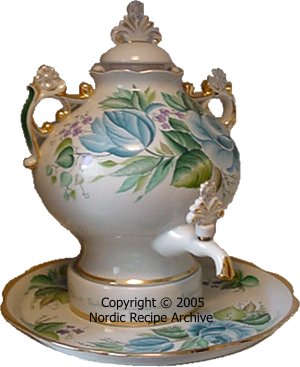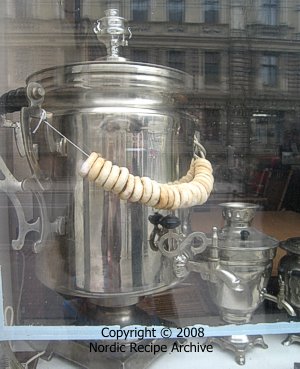
|
|||||||||
| MAIN RECIPE PAGE |
|
||||||||
|
RUSSIAN TEA
The Russian tea may include a whole meal from savoury snacks to sweet desserts, especially when served in the evening. The evening tea — vechernii chai — may either be a light meal eaten late at night after dinner or a whole meal eaten instead of dinner. Samovar In the old days, the traditional Russian tea water cooker, samovar, was the showy centrepiece of the Russian tea table. The word "samovar" literally means "self-cooking", from the Russian words sam — "self", and varit' — "to cook".
Samovar was the sign of prosperity. Wealthy families used to have several samovars, from the ones used daily to those displayed only as decorative objects. Some even had a whole room dedicated to the samovar only. Nowadays stovetop or electric tea kettles have come to replace the traditional samovars in everyday life, but they are still used at festive occasions at home, on picnics, and at restaurants and hotels serving Russian teas. Even today the samovar is a symbol of the warm Russian hospitality. Structure of samovar There are many shapes and sizes of samovars. The body of modern samovars is usually round, resembling either a cylinder, sphere, vase, pear, goblet or barrel. The basic structure of samovar consists of a large body (tulovo, vaza) enclosing a water container, mounted on a raised base (poddon), consisting of the neck (sheika) and legs of various designs (see the drawing below).
Note: the drawing above shows the structure of an electric samovar
In picture on left: vintage samovars on display in an antique shop window. In the upper part of the neck, there is a ventilation chamber (reshetka) for accessing oxygen to the fuel tube. Bellows may be used to feed the fire. Attached to the lower part of the body is a faucet (kran), operated with a simple valve (kliuch), for pouring out the hot water in teacups. Handles (ruchki) for lifting and moving the samovar are attached on the upper part of the body. Samovar is closed with a wide lid (kryshka) on top of which there is a raised, ring-shaped base (konforka) for holding a teapot (chainik). The lid has small holes (otdushniki) for steam to escape and small knobs (shishki) for lifting it.
In picture on right: the inside of a vintage electric samovar. Electric samovars, introduced in the 1950s, are almost identical to those heated with fuel, only they contain an electric heating element and a coiled heater inside, instead of a fuel pipe (see the picture on right). Serving tea using a samovar The water for tea is heated in the samovar. Strongly concentrated tea (zavarka) is brewed in a separate, small teapot (zavarnik). The pot is kept warm by placing it on the konforka on top of the hot samovar (see the drawings below).
To serve the tea, a small amount of the tea concentrate is poured in teacups (chainye chashki) through a small tea sieve (sitechka) and diluted to taste with the boiled water (kipiatok) from the samovar. Russian tea table setting
The Russian tea table may be set similarly to the Russian buffet, the zakuska table, or the Scandinavian buffet table smörgåsbord, where all dishes to be served are placed together on the table. Their amount may vary, according to the occasion, from a light evening snack consisting of only a few cold dishes to an abundant, full scale evening banquet buffet.
For a simple meal, a few pastries and biscuits may be served, placed in baskets on the table. Next to these are placed small bowls filled with different jams and confectionaries. Containers for sugar or honey and thinly sliced lemon are placed beside.
For beverages, teacups, drinking glasses and/or wine glasses are set. Instead of teacups, tea may be served from tea glasses placed in metallic glass-holders. In addition to tea, mineral water and/or dessert wine or stronger spirits may be served. For a more abundant meal, also butter, bread, cold cuts and cheese are set on the table for making open-faced sandwiches. When the tea is to replace a meal, the amount of dishes served is increased. No one should leave the table feeling hungry. But no matter how much or little food is served, when gathered round the Russian tea table the main thing is to create a relaxed, warm and cosy atmosphere with lively conversation that will make every guest feel welcome and appreciated. See suggestions for some dishes to serve at a Russian tea table. |
|||||||||
|
|||||||||
 Tea is widely enjoyed in Russia, where it is drunk throughout the day, from breakfast to night. Besides the tea, various small sweet or savoury dishes are usually served.
Tea is widely enjoyed in Russia, where it is drunk throughout the day, from breakfast to night. Besides the tea, various small sweet or savoury dishes are usually served.
 The town of Tula is known as the centre of the Russian samovar manufacture. The first
The town of Tula is known as the centre of the Russian samovar manufacture. The first 
 Inside the water container, running vertically through the centre of it from bottom to top, is a narrow, hollow tube (kuvshin) where the fuel — wood chip, firewood, pine cones, charcoal — for heating up the samovar is placed.
Inside the water container, running vertically through the centre of it from bottom to top, is a narrow, hollow tube (kuvshin) where the fuel — wood chip, firewood, pine cones, charcoal — for heating up the samovar is placed.
 Since fuel-burning samovars generate smoke, they also need to be fitted with a chimney pipe attached to the top of the fuel tube while working, or used outdoors. Working samovar is smothered by
placing a small cap (kolpachok) on top of the konforka, to block the fuel tube.
Since fuel-burning samovars generate smoke, they also need to be fitted with a chimney pipe attached to the top of the fuel tube while working, or used outdoors. Working samovar is smothered by
placing a small cap (kolpachok) on top of the konforka, to block the fuel tube.



 Traditionally the samovar was always placed on a separate small table or stool, near the hostess' place at the dinner table, since it was her duty to pour the tea for the guests.
Nowadays, at home, the samovar may also be placed on the end of the dinner table, together with teacups or glasses.
Traditionally the samovar was always placed on a separate small table or stool, near the hostess' place at the dinner table, since it was her duty to pour the tea for the guests.
Nowadays, at home, the samovar may also be placed on the end of the dinner table, together with teacups or glasses.

 Dishes set on the table should include dessert plates with napkins, dessert forks and knives, together with small separate plates and teaspoons for eating jam.
Dishes set on the table should include dessert plates with napkins, dessert forks and knives, together with small separate plates and teaspoons for eating jam.